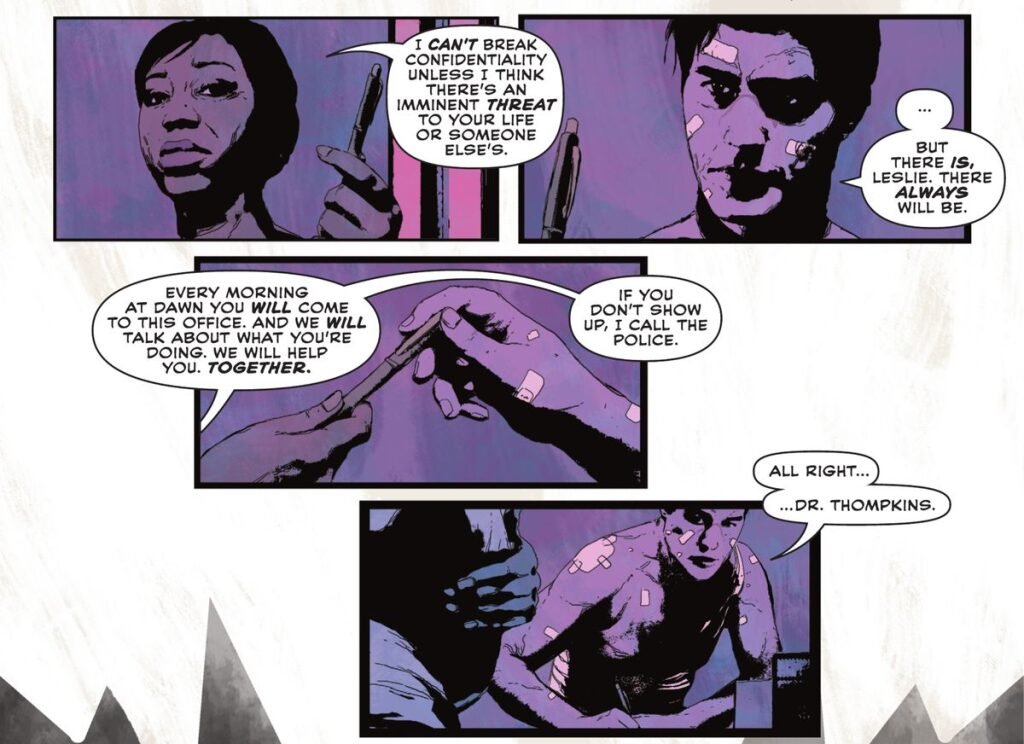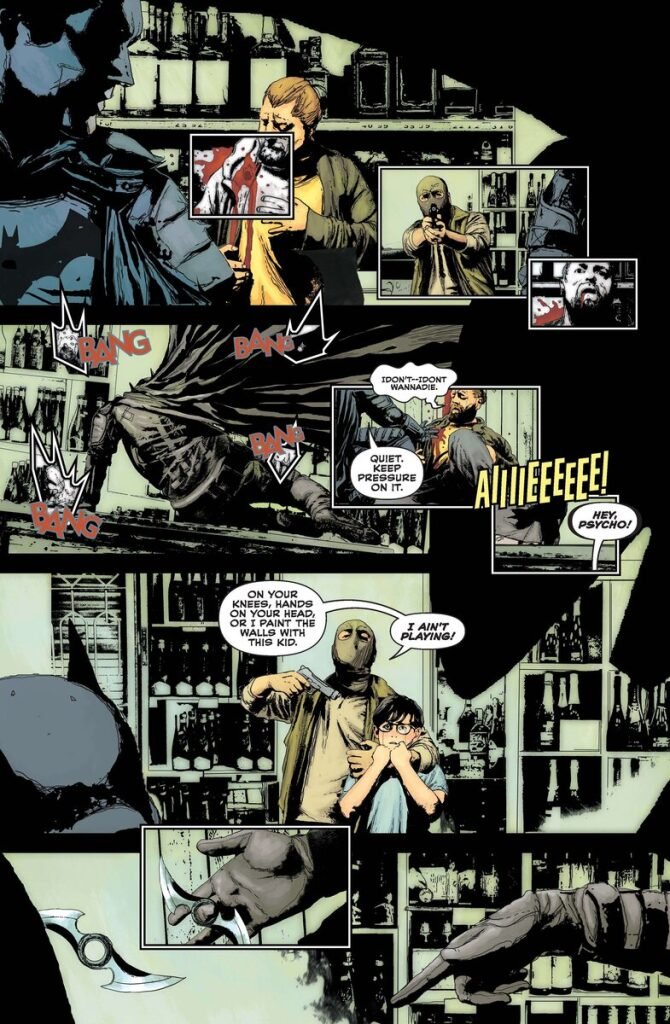Writer: Mattson Tomlin
Artist: Andrea Sorrentino
DC Comics, 2021

If we had to choose the best superhero comic book so far this decade, it must be Batman: The Imposter. The story has been issued under American superhero comic publisher DC Comics’ Black Label imprint. As we have previously discussed, the Black Label imprint grants extended license to a creative team, because the story does not need to be set within DC Comics’ labyrinthine comic book history. Reading some of these titles, and especially this one, are akin to watching a motion picture, adapted from comic book content but not beholden to a purity of continuity.
We did not know about Mr Tomlin’s cinematic credentials when it occurred to us that reading this comic was like watching a movie. Wikipedia notes that in 2019 Mr Tomlin was an uncredited co-writer on The Batman (2022) movie, and is contributing to its sequel. And indeed, upon reflection, this comic slots very neatly into the continuity of that movie. Bruce Wayne is depicted as a young man, tormented by the memories of his parents’ execution, and is suffering from very significant mental health issues.
Even casual readers of DC Comics titles know that any residual naivety from Batman’s year of creation, the concept of a rich orphan dressing up in a costume to happily fight crime, has long passed. Objectively, the character’s conduct is positively insane. The psychology of Batman’s war on crime has been the subject of self-deferential critique (both Frank Miller’s All-Star Batman and Robin and Warren Ellis’ character Midnighter stand out), and also led to many parodies, our favourite of which is this:

Dr Leslie Thompkins is an infrequent visitor in the regular Bat-verse, and here she is Bruce Wayne’s childhood psychiatrist who Batman turns to when he is severely injured in a fight. Having the Batman turn up bloodied and broken on the lounge room floor is one thing: removing the vigilante’s mask and finding that he is your orphaned billionaire patient from a decade ago is a genuine shock for the doctor. In an effort to help Batman, Dr Thompkins threatens him. If he agrees to sign her on as his psychiatrist then she will not report him to the police. It is a useful narrative tool, because instead of speaking in a never-ending boxed monologue (the Bat-monologue is Frank Miller’s murderous offspring, its victim being the thought bubble), Batman explains events and his thinking to his mental health care provider and thereby to the reader. Batman is completely honest to Dr Thompkins and as such is completely honest to us. But Dr Thompkins recognises Bruce Wayne for what he is, and in doing so, Mr Tomlin gives us his own assessment:
Batman: Where are my clothes…
Thompkins: When you say “clothes”, you mean the bat costume you wear to assault people in the street every night?
It gets much harsher from here:
Batman: I went to the ends of the earth to learn to control the monster. Not to purge the fear or the pain. But to become it.
Thompkins: …. Bruce, I say this as a psycho-therapist… you sound insane.
Dr Thompkins diagnosed the twelve year old Bruce Wayne as suffering from “Social withdrawal. Oppositional defiance disorder. PTSD. A disturbing lack of empathy. Anxiety. OCD.” Young Bruce has broken the jaw of one fellow student and broken another’s nose. And it is clear that years later he has never mastered his fury. There is no ambiguity about Batman’s mental health. He is not merely a grim superhero.
Veteran readers of the exploits of the caped crusader, as he was called in a happier, different era, may well roll their eyes. But the fury which consumes Bruce Wayne is stoppable. Endeavouring to follow up leads on the identity of the Batman, police detective Blair Wong calls on Bruce Wayne at his almost derelict Wayne Manor. Batman tells Thompkins that he is romantically interested in the detective and, to everyone’s surprise, it becomes meaningful. One point of attraction is that Blair is Gotham City Police Department’s best detective, and the other is the shared trauma of having both parents murdered by criminals in front of their eyes – more in this in due course.
Bruce himself is not entirely clear about his motivations. But the effect of the relationship is something he feels, a counterpoint to unrelenting fury: “We’re the only ones who could ever understand each other,” he tells Dr Thompkins of Blair. Until he became involved with Blair, Bruce says, there was nothing but rage. Now, he tells Dr Thompkins, he is in love. As they kiss, the red umbrella which Blair had been holding is swept away by the wind. It is a wonderfully symbolic double-pass spread, in which grotesque clouds around the couple seem to swirl and heave, and yet the two stand in the middle, untouched.

Other things are very different from the regular Batman titles. The glaring example is that Batman in this title has no allies. There are no sidekicks, no fellow superheroes to rely upon. Police Commissioner James Gordon has been ousted from his role, viewed by authorities as complicit in Batman’s vigilantism. The butler Alfred Pennyworth is not Batman’s trusted lieutenant. Instead, Pennyworth quit after dealing with the young Bruce Wayne’s dangerous tantrums (including, somewhat amusingly, an effort to make explosives out of fertiliser) and Bruce was sent off by Pennyworth to a “military school in Russia”. (We wryly note that no doubt that learning environment would not have assisted Bruce deal with his PTSD, but it also explains some of Batman’s skills. Batman’s tactical thinking and fighting skills in this story might have been the result of Spetznaz training, and indeed some of his situational awareness suggests Systema.)
Batman’s preference in weaponry is frightening: the once harmless batarang is in this title a vicious amalgam of a switchblade and a fidget spinner. Batman uses it to slash the faces of his adversaries and towards the end blind the right eye of the Imposter.
Other little differences make up a picture of realism: Batman does not have an easily followed Batmobile but instead has left dozens of motorcycles all over the city as transportation. There is no cave, no Bat signal, no grey tights. This Batman wears body armour and water-boards suspects.
Mr Tomlin at one point invites us to think about symbols. There was a thug from out of town who decided to call himself “The Squid”. The Squid quickly became a target for the local underworld because the Squid “did not recognise the importance of symbolism in this city.” The Imposter offers more than bats, cats, playing cards and penguins. In Alan Moore’s and Brian Bolland’s classic Batman story The Killing Joke, the rear cover famously features a mock playing card with Batman and the Joker depicted as the mirror of each other. Thanks to the wonderful skills of artist Andrea Sorrentino, mirrors abound throughout The Imposter, starting with the front cover, in which Batman glances over his shoulder through shattered glass at an obscured reflection. But the mirror is not simply confined to the fake Batman who is terrorising the city and killing criminals. Reflections are quite literal, such as when Blair carefully thinks through her relationship with Bruce Wayne: the juxtaposition between the comfortable intimacy and the violence in which, during a melee, he kicks her metres into the air (something in a conversation with Dr Thompkins he sincerely regrets).
Throughout the title, Blair is the mirror image of Bruce. Having gone through the same childhood horror, Blair chooses to become a police detective. Her desire to punish criminals manifests in a quite rational if sad way. It is a conventional path, to which Batman’s combat training and war on crime is a perverse reflection in a funhouse mirror. Mr Bolland’s Joker is not the reflection of Batman. Blair is a much clearer, polished mirror image.
Mr Sorrentino also uses a technique which we have seen deployed by JH Williams III in Desolation Jones and by Gerardo Zaffino in Karnak: dynamic panels within panels, in which very specific points of action – often injuries – are highlighted in monochrome. This works extremely well in focussing the reader’s attention upon the action. Everything else in the larger panel seems to stop, as the action occurs in the panel within the panel.
There is no definitive conclusion to Batman: The Imposter. Blair and Bruce are estranged. Bruce leaves flowers at the graves of his own parents, Blair’s parents, and the fresh grave of a hapless rat catcher who thought he was helping Batman. The imposter himself is dead. Dr Thompkins has a new patient. A sequel to this impeccable title would be unnecessary. But we cross our fingers nonetheless.


